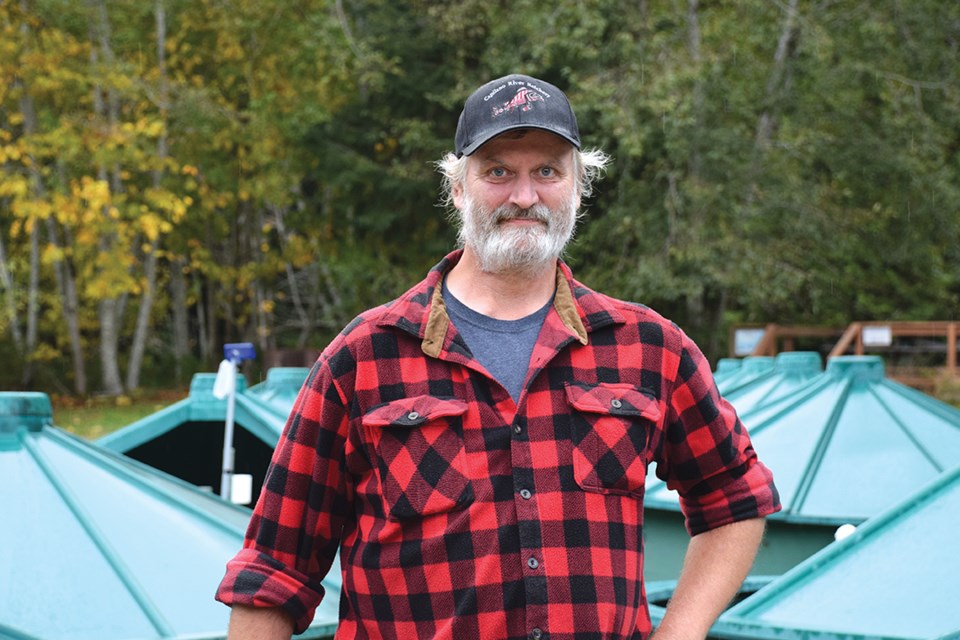As winter approaches, Chapman Creek Hatchery is preparing to babysit thousands of salmon eggs with the help of new leadership and some new technology.
Bill Krause, the new manager and executive director, joined Chapman Creek Hatchery in March. He brings his expertise as a fish culturist, and decades of experience at Capilano Salmon Hatchery in North Vancouver as well as time at Squamish’s Tenderfoot Creek Hatchery.
It’s not his first time handling salmon from Chapman Creek. In the summer 2018, he helped take care of the salmon from the Chapman hatchery when they were housed at the Capilano facility. He has since been reunited with those Chapman fish, which have grown into adults and are providing this year’s eggs.
In mid-October, a group of volunteers helped begin the egg take from the hatchery’s coho population of 45 females and 68 males. Milt from male salmon was used to fertilize the eggs. One female salmon produced 3,255 eggs, and Krause hopes to get between 60,000 and 65,000 coho eggs to raise and release. The hatchery has almost 89,000 pink salmon eggs in incubation.
As another addition to the hatchery, Krause is using cameras and an app on his phone that allow him to monitor the incubation pans remotely, keeping an eye on water temperature and any blockages. He hopes to speed up the incubation time and increase growth in the tubs so the released fish have a better chance at survival than their predecessors.
This past summer, the Chapman hatchery had only enough well water to keep 2,500 coho salmon cool in their tanks during the drought conditions. The rest of the coho were taken to Port Mellon for the season, where they were raised inside without natural daylight. Krause visited the 25,000 fish at Port Mellon for 10 weeks, until they could be returned to the Chapman hatchery.
“Bill went down there every single day to hand-feed those fish,” the hatchery vice president, Pat Moore, said. Except for a few days, he fed the coho daily and checked the water temperature, monitoring their growth and oxygen levels.
Once the coho were reunited, Krause compared the sizes of those raised inside the Port Mellon facility to the group kept at the hatchery. The coho kept at Chapman grew to be larger than those at Port Mellon, weighing in at more than five grams compared to the average 3.75 grams of the relocated fish.
Three test wells were dug in the past few months, and the hatchery team hopes recent testing will allow them to use well water to cool the fish and keep them through the summer next year.
Right now, the hatchery is home to coho and pink salmon, and the team hopes to get a few more pairs of chinook salmon. Eventually, they would like to get trout again.
Despite a downpour of rain on Oct. 15 and 16, a group of around 20 volunteers also helped fin-clip more than 22,000 coho fry at the hatchery. Clipping the adipose fin marks the fish after their release in May, so they can be identified when they return to the creek in the fall.
Some of the volunteers were fishing in the creek at the time, and joined the effort at the hatchery’s request for help.
Wendy Gunson, the director of volunteers, and Moore credit Krause with a recent increase in volunteers.
“He’s very passionate about what he’s doing, and he’s very careful,” Moore said.
“And volunteers love him,” Gunson added, “because he will teach them anything they don’t know, and he’ll explain things so that they understand.”
The hatchery is always looking for volunteers, Gunson said. The hatchery’s summer camp was able to resume this year with limited numbers, with around 128 kids taking part over eight weeks. The team hopes younger volunteers will be inspired to join. Anyone interested in volunteering can find more information at scsalmon.org.



